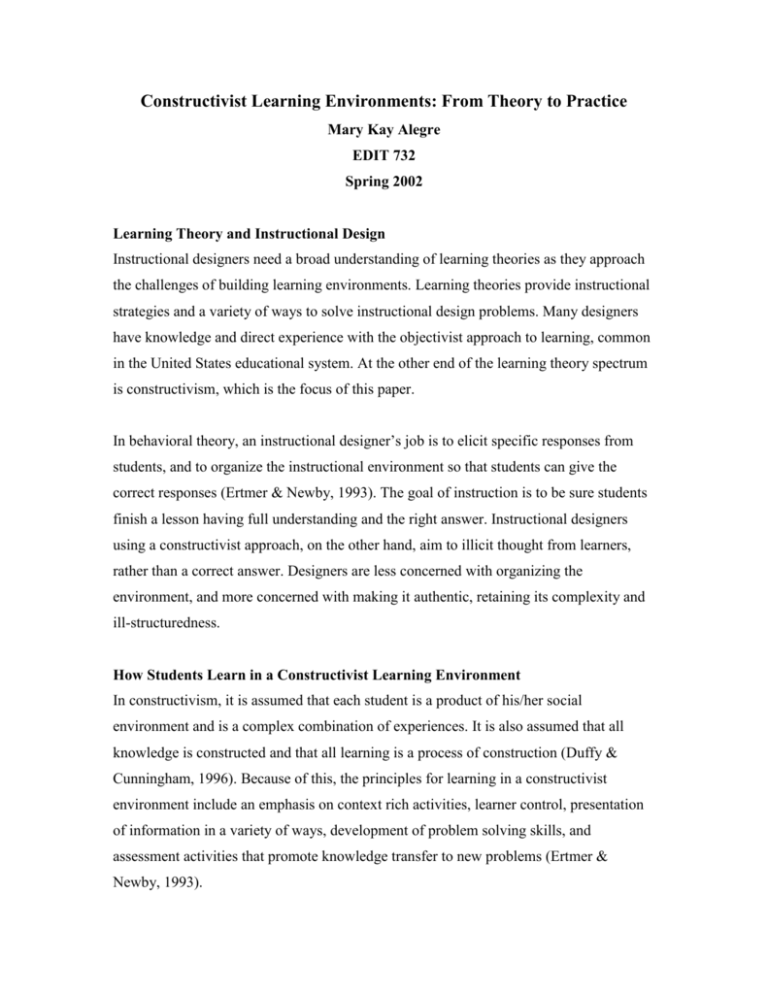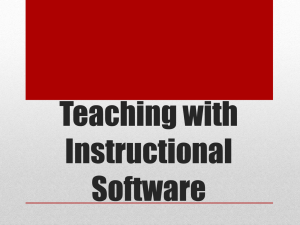Paper
advertisement

Constructivist Learning Environments: From Theory to Practice Mary Kay Alegre EDIT 732 Spring 2002 Learning Theory and Instructional Design Instructional designers need a broad understanding of learning theories as they approach the challenges of building learning environments. Learning theories provide instructional strategies and a variety of ways to solve instructional design problems. Many designers have knowledge and direct experience with the objectivist approach to learning, common in the United States educational system. At the other end of the learning theory spectrum is constructivism, which is the focus of this paper. In behavioral theory, an instructional designer’s job is to elicit specific responses from students, and to organize the instructional environment so that students can give the correct responses (Ertmer & Newby, 1993). The goal of instruction is to be sure students finish a lesson having full understanding and the right answer. Instructional designers using a constructivist approach, on the other hand, aim to illicit thought from learners, rather than a correct answer. Designers are less concerned with organizing the environment, and more concerned with making it authentic, retaining its complexity and ill-structuredness. How Students Learn in a Constructivist Learning Environment In constructivism, it is assumed that each student is a product of his/her social environment and is a complex combination of experiences. It is also assumed that all knowledge is constructed and that all learning is a process of construction (Duffy & Cunningham, 1996). Because of this, the principles for learning in a constructivist environment include an emphasis on context rich activities, learner control, presentation of information in a variety of ways, development of problem solving skills, and assessment activities that promote knowledge transfer to new problems (Ertmer & Newby, 1993). One might think that if all learning is constructed by an individual, and all individuals have a different set of experiences and knowledge constructs, that there would be chaos, especially when it comes to education. Constructivists argue, however, that knowledge comes from a process of social negotiation – and although all people have different perspectives, we live in the same world and seek meaning as human beings. Meaning, though, is never constant. Negotiation is continual and ongoing throughout time, cultures, and generations. It is for this reason that no instructional designer can determine what a student should know going into a lesson, or what a student should come out with at the end of a learning experience. What a constructivist instructional designer should not do is prescribe instruction, but rather provide opportunities for exposure to authentic environments for learning. Authentic environments allow students to experience and use the tools of that domain, negotiate meaning with others, and learn through a process of enculturation. An authentic environment is one that “must at least have some of the important attributes of real-life problem solving including ill-structured complex goals, an opportunity for the detection of relevant versus irrelevant information, active/generative engagement in finding and defining problems as well as in solving them, involvement of the student’s beliefs and values, and an opportunity to engage in collaborative interpersonal activities” (Young, 1993). Assessment in a Constructivist Learning Environment Assessment in constructivist learning environment is difficult because it clashes with standardized testing, a long-held educational tradition in this country. In constructivism, outcomes are important in two areas: “that the perspective that each student develops in the content area is effective in working in that area and, that the student can defend his/her judgment” (Bednar, Cunningham, Duffy & Perry, 1992). These outcomes are difficult, time-consuming and costly to measure following a standardized testing model. The U.S. culture needs to think differently about the purpose of education in order for it to embrace constructivist learning environments and the kind of assessment needed to gauge learning outcomes. Application of a Constructivist Learning Theory – A Cognitive Apprenticeship There are many applications of constructivist learning theories. One method is the cognitive apprenticeship. This method has its roots in history, when apprentices learned trades from master craftsmen. In a modern day cognitive apprenticeship, students (apprentices) benefit from certain instructional strategies that allow them to experience the situated nature of knowledge (Brown, Collins, Duguid, 1989). In authentic situations, students are exposed to tools used in a particular domain, and to a community of practitioners, some of whom are considered experts and who share their internalized processes of thinking. Experts provide scaffolding, coaching and modeling of cognitive skills. Over time, as this community of practice, students become more active in the culture, taking on responsibility for generating their own solutions -- depending less on the support from experts. Real-life Application of A Cognitive Apprenticeship for the U.S. Forest Service A prototype of a cognitive apprenticeship, or more specifically a cognitive teleapprenticeship was designed and developed for the U.S. Forest Service. A cognitive teleapprenticeship works from distance, and in the case of this project, using Internet technology. It is particularly appropriate for this government agency because of its long held, but fast fading tradition of learning through informal apprenticeships. With a significant level of retirement among senior managers, considered experts, and many new managers starting their careers, the Forest Service could benefit from providing management and decision-making training through an online teleapprenticeship. Capturing the knowledge of the experts, and digitizing it for the use of generations of new managers to come would solve an anticipated management crisis. Using the instructional theories offered by Collins and Brown, novice managers can learn how to solve the complex problems that they will encounter in their careers as managers. Internet technology will allow students to build the kind of social support system and community necessary for knowledge building to occur in a cognitive apprenticeship. Applying the Project Model to Other Domains Public and private sector entities alike have training problems as the Forest Service – how to provide training to emerging managers capturing the knowledge of those who have gone before. The elements described in this cognitive apprenticeship prototype could be easily adapted for use in all sectors of government and in the private sector. References Bednar, A. K., Cunningham, D., Duffy, T. M. & Perry (1992). Theory into practice: How do we link? In T. M. Duffy & D. H. Jonassen (Eds.), Constructivism and the technology of instruction (pp. 17-34). Hillsdale, NJ: Lawrence Erlbaum Associates. Brown, J. S., Collins, A. & Duguid, P. (1989). Situated cognition and the culture of learning. Educational Researcher, January/February, 32-42. Duffy, T. M. & Cunningham, D. J., Constructivism: Implications for the design and delivery of instruction. In D. H. Jonassen (Ed.), Handbook of research for educational communications and technology (pp. 170-198). New York, NY: Simon and Schuster MacMillan. Ertmer, P.A. & Newby, T. J. (1993). Behaviorism, cognitivism, constructivism: Comparing critical features from an instructional design perspective. Performance Improvement Quarterly, 6(4), 50-72. Young, M. F. (1993). Instructional design for situated learning. Educational technology research and development, 41(1), 43-58.








